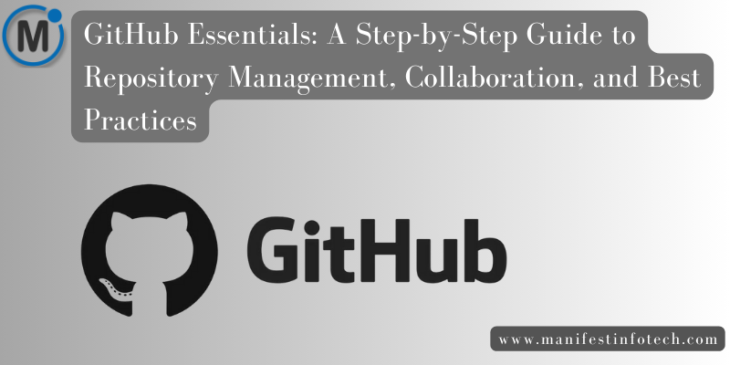
In this post, we’ll walk you through the GitHub essentials, covering repository management, collaboration tools, and best practices.
𝐔𝐧𝐝𝐞𝐫𝐬𝐭𝐚𝐧𝐝𝐢𝐧𝐠 𝐆𝐢𝐭𝐇𝐮𝐛 𝐑𝐞𝐩𝐨𝐬𝐢𝐭𝐨𝐫𝐢𝐞𝐬:
𝟏. 𝐂𝐫𝐞𝐚𝐭𝐢𝐧𝐠 𝐚 𝐑𝐞𝐩𝐨𝐬𝐢𝐭𝐨𝐫𝐲: To start a project on GitHub, you need a repository. Click the “+ New” button on the GitHub homepage, provide a name, description, and choose visibility (public or private). Initialize with a README for a quick start.
𝟐. 𝐁𝐫𝐚𝐧𝐜𝐡𝐢𝐧𝐠: Branches allow you to work on different versions of your project simultaneously. The default branch is usually ‘main’ or ‘master’. Create branches for features or bug fixes, and merge them back when ready.
𝟑. 𝐂𝐨𝐦𝐦𝐢𝐭𝐬: Commits are snapshots of your project. Each commit records changes to the repository, making it easier to track modifications and roll back if needed. Write clear and concise commit messages.
𝟒. 𝐏𝐮𝐥𝐥 𝐑𝐞𝐪𝐮𝐞𝐬𝐭𝐬: Pull requests (PRs) are proposed changes that you want to merge into the main branch. They facilitate code review and discussion before integration. PRs are a cornerstone of collaboration.
𝐂𝐨𝐥𝐥𝐚𝐛𝐨𝐫𝐚𝐭𝐢𝐨𝐧 𝐚𝐧𝐝 𝐂𝐨𝐦𝐦𝐮𝐧𝐢𝐜𝐚𝐭𝐢𝐨𝐧:
𝟏. 𝐅𝐨𝐫𝐤𝐬 𝐚𝐧𝐝 𝐂𝐥𝐨𝐧𝐢𝐧𝐠: Forking a repository creates a copy under your GitHub account. Clone it locally to work on changes. After modifications, submit a pull request to contribute back.
𝟐. 𝐈𝐬𝐬𝐮𝐞𝐬: Use GitHub Issues to track tasks, enhancements, bugs, or any discussion related to your project. Issues are an excellent way to manage and prioritize work.
𝟑. 𝐏𝐫𝐨𝐣𝐞𝐜𝐭 𝐁𝐨𝐚𝐫𝐝𝐬: GitHub’s project boards help you organize and manage work with Kanban-style boards. Create custom boards to track progress and categorize tasks.
𝟒. 𝐃𝐢𝐬𝐜𝐮𝐬𝐬𝐢𝐨𝐧𝐬: GitHub Discussions provide a space for broader conversations beyond code. Use it for Q&A, general discussions, or brainstorming ideas.
𝐁𝐞𝐬𝐭 𝐏𝐫𝐚𝐜𝐭𝐢𝐜𝐞𝐬:
𝟏. 𝐑𝐄𝐀𝐃𝐌𝐄 𝐅𝐢𝐥𝐞: A good README.md is essential. It should include project information, installation instructions, usage guidelines, and contribution guidelines. A clear README attracts contributors and users.
𝟐. .𝐠𝐢𝐭𝐢𝐠𝐧𝐨𝐫𝐞 𝐅𝐢𝐥𝐞: Use a .gitignore file to specify which files or directories should be ignored by Git. This prevents unnecessary files (like logs or compiled binaries) from cluttering your repository.
𝟑. 𝐁𝐫𝐚𝐧𝐜𝐡 𝐏𝐫𝐨𝐭𝐞𝐜𝐭𝐢𝐨𝐧: Protect the main branch to prevent accidental force pushes or direct commits. Enforce code review before merging to maintain code quality.
𝟒. 𝐂𝐨𝐧𝐭𝐢𝐧𝐮𝐨𝐮𝐬 𝐈𝐧𝐭𝐞𝐠𝐫𝐚𝐭𝐢𝐨𝐧 (𝐂𝐈): Set up CI tools like GitHub Actions or Travis CI to automate testing and code quality checks. This ensures that each pull request meets the project’s standards.
𝟓. 𝐋𝐢𝐜𝐞𝐧𝐬𝐢𝐧𝐠: Clearly define your project’s license. GitHub provides a license picker to help you choose the right license for your project. This informs users and contributors about how they can use, modify, and distribute your code.
GitHub is more than just a version control system; it’s a collaborative platform that empowers developers to work together seamlessly. By mastering these GitHub essentials and incorporating best practices, you’ll enhance your development workflow, foster collaboration, and contribute to the open-source community effectively.
If you are looking for any services related to Website Development, App Development, Digital Marketing and SEO, just email us at nchouksey@manifestinfotech.com or Skype id: live:76bad32bff24d30d
𝐅𝐨𝐥𝐥𝐨𝐰 𝐔𝐬:
𝐋𝐢𝐧𝐤𝐞𝐝𝐢𝐧: linkedin.com/company/manifestinfotech
𝐅𝐚𝐜𝐞𝐛𝐨𝐨𝐤: facebook.com/manifestinfotech/
𝐈𝐧𝐬𝐭𝐚𝐠𝐫𝐚𝐦: instagram.com/manifestinfotech/
𝐓𝐰𝐢𝐭𝐭𝐞𝐫: twitter.com/Manifest_info
#GitHub #VersionControl #CodeManagement #CollaborativeCoding #SoftwareDevelopment #GitBestPractices #RepositoryManagement #GitHubGuide #CodingTips #DevOps #OpenSource #Programming #CodeCollaboration #GitHubWorkflow #TechGuides #CodeReview #DeveloperTools #ContinuousIntegration #SoftwareEngineering #ProjectManagement